PREVIOUS: JAPAN-MATSUE
LAFCADIO HEARN'S LAST YEARS
KUMAMOTO-KYOTO-TOKYO 1891 - 1904
KUMAMOTO, KYUSHU 1891-94
After the bitterly cold winter in Matsue a shivering Hearn took a teaching job at Kumamoto, "a vast, straggling, dull, unsightly
town" in Kyushu, the southern-most of the Islands of Japan. Though not "tropical" - Hearn recalls his stay in the West-Indies, Kumamoto is climatically at least bearable.
Nina Kennard describes Hearn's move to Kumamoto:
"He began to look back with regret to the days passed
in the "Fairyland" of Matsue: "You must travel out of Izumo," he told himself and find out how unutterably
different Matsue is from other places. - For instance, in this country (Kumamoto) the charming simplicity of the Izumo folk
does not exist."
All his Izumo servants had accompanied him to his new
quarters, and apparently all his wife 's family, for he mentions
the fact that he has nine lives dependent upon him :
his wife's mother, wife's father, wife's adopted mother,
wife's father's father, his servants, and a Buddhist student. Not to mention (sic!) his wife and new-born son."
From Nina Kennard,
KUMAMOTO STUDENTS 1894
Hearn found the "new reality" of Japan most startling in his students at the government college where he taught.
"The students of the Government College, or
Higher Middle School, can scarcely be called
boys ; their ages ranging from the average of
eighteen, for the lowest class, to that of twenty-
five for the highest. The best pupil can hardly hope
to reach the Imperial University before his
twenty-third year, and will require for his entrance
there into a mastery of written Chinese
as well as a good practical knowledge of
either English and German, or French.
The impression produced upon me by the
Kumamoto students was very different from
that received on my first acquaintance with
my Izumo pupils. Kyushu still remains, as of yore, the
most conservative part of Japan, and Kumamoto,
its chief city, the centre of conservative
feeling. This conservatism is, however, both
rational and practical. Kyushu remains of all districts of the
Empire the least inclined to imitation of
Western manners and customs. The ancient
samurai spirit still lives on; and that spirit exacted
severe simplicity in habits of life.
Kumamoto
is proud of all these things, and boasts of her
traditions. Indeed, she has nothing else to
boast of. A vast, straggling, dull, unsightly
town is Kumamoto : there are no quaint,
pretty streets, no great temples, no wonderful
gardens. A wilderness of flimsy
shelters erected in haste.
The Kumamoto youths, - whenever not obliged to don military uniform - still cling to a costume
somewhat resembling that of the ancient bushi. They, though born to comparative wealth, find no pleasure so keen as that of
trying how much physical hardship they can
endure.
For a long time I used to wonder But later on, at frequent intervals,
came to me suggestions of an inner life much
more attractive than this outward appearance : hints of an emotional individuality. A few I
obtained in casual conversations, but the most
remarkable in written compositions."
A lengthy description follows of his methods of teaching, of themes and questions Hearn posed to his students and their answers.
From Elizabeth Bisland, 1895
KOBE and KYOTO 1894-96
After Kumamoto Hearn took another teaching job at Kobe, a military garrison town and naval harbor neither pretty nor quaint. He lived with his wife and child in a pretty enough house high above Suma Beach, immortalized by the Genji and the Heike Monogatari. Nevertheless he hated Kobe, and all his black visions resurfaced.
.
THE TIME OF THE CHOLERA 1894
"Cholera had come with the victorious Japanese army from
China, and had carried off, during the hot season, about
thirty thousand people.
Sometimes the smoke and the odor
come wind-blown into my garden down from the
hills behind the town.
From the upper balcony of my house, the whole
length of a Japanese street, with its rows of little
shops, is visible down to the bay. Out of various
houses in that street I have seen cholera-patients
conveyed to the hospital - the last one (only this
morning) my neighbor across the way. He was removed by force, in spite
of the tears and cries of his family. The sanitary
law forbids the treatment of cholera in private
houses; yet people try to hide their sick. My neighbor's wife followed the litter,
crying, until the police obliged her to return to
her desolate little shop.
The children sport as usual. They chase one
another with screams and laughter; they dance in
chorus; they catch dragon-flies and tie them to long
strings; they sing burdens of the war, about cutting
off Chinese heads.
A pipe-stem seller used to make his round with
two large boxes suspended from a bamboo pole balanced
upon his shoulder: one box containing stems
of various diameters, lengths, and colors, together
with tools for fitting them into metal pipes; and
the other box containing a baby — his own baby.
The other day I discovered that he
had abandoned his bamboo pole and the suspended
boxes. He was coming up the street with a
little hand-cart just big enough to hold his wares and
his baby, evidently built for that purpose with
two compartments. The
child seemed well and happy. Among its toys I noticed a
tablet-shaped object. It was fastened upright to a
high box in the cart facing the infant's bed.
There was no mistaking the tablet
was a Shinshu ihai, a memorial tablet bearing a woman's kaimyo, or
posthumous name.
With the help of our maid the pipe-stem seller told us his story:
Two months after the birth of their little boy, his
wife had died. In the last hour she had
asked him: "From the time I die till three full years be
past I pray you to leave the child always united
with the Shadow of me: never let him be separated
from my ihai, so that I may continue to care for him
and to nurse him."
The pipe-stem seller could not afford to buy milk; but he had
fed the boy for more than a year with rice gruel and
ame syrup.
I said that the child looked very strong, and none
the worse for lack of milk. "That," he declared in a tone of conviction bordering on reproof, "is because his dead
mother nurses him. How should he want for milk?"
And the boy laughed softly, as if conscious of a
ghostly caress".
From Elizabeth Bisland. 1922
KOBE 1893 - 1896
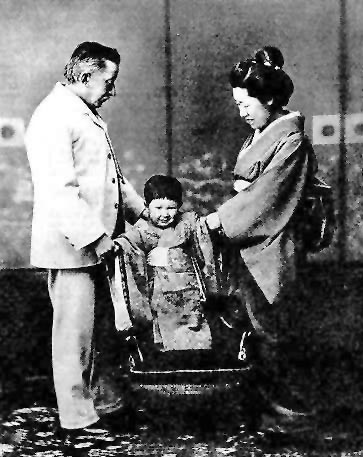
Hearn, Setzu, and Kazuo in Kobe, 1893
Photo from trussel.com
Hearn was now married. He was gaining weight. His wife took happily credit for it. Little Katsuo was growing fast. Lafcadio was teaching English literature in another middle school.
THE ETERNAL FEMININE 1896
"Teacher, please tell us why there is so
much about love and marrying in English
novels ; - it seems to us very, very strange."
This question was put to me while I was trying
to explain to my literature class - young
men from nineteen to twenty-three years of
age - why they had failed to understand certain
chapters of a standard novel, though they were quite
able to understand the logic of Jevons
and the psychology of James.
Under the circumstances,
it was not an easy question to
answer. As it was, though
I endeavored to be concise as well as lucid,
my explanation occupied something more than
two hours.
Any social system of which filial piety is not
the moral cement ; any social system in which
children leave their parents in order to establish
families of their own ; in which it is considered not only natural but
right to love wife and child more than the
authors of one's being; any social system in
which marriage can be decided independently
of the will of the parents, by the mutual inclination
of the young people themselves ; in which the mother-in-law is not
entitled to the obedient service of the daughter-
in-law, appeared to them of necessity a state
of life scarcely better than that of birds and the beasts of the field, at best a sort of moral chaos.
To the young Japanese,
marriage appears a simple, natural duty,
for the due performance of which his parents
will make all necessary arrangements at the
proper time. That foreigners should have so
much trouble about getting married is puzzling
enough to them ; but that distinguished authors should write novels and poems about
such matters, and that those novels and poems
should be vastly admired, puzzles them infinitely
more, - it seems to them put politely " very, very
strange." His real thought would have
been more accurately rendered by the word "indecent."
Now, where passionate love is the theme in
Japanese literature, it is not the
love which leads to the establishment
of family relations. It is quite another
kind of love - about which the
Oriental is not prudish at all, - the mayoi,
or infatuation of passion, inspired by
physical attraction. Its heroines are not
the daughters of refined families, but
hetaerae, or professional dancing-girls....
Let the reader
reflect for a moment how large a place the
subject of kisses and caresses and embraces
occupies in our poetry and prose
fiction ; and then let him consider the fact that
in Japanese literature these have no existence
whatever. For kisses and embraces are simply
unknown in Japan as tokens of affection."
Hearn, the shy Irish-Greek man sums up his 40-pages-long eloquent plaidoyer for Japanese virtues with the sentence:
"Western worship of Woman as the Unattainable,
the Incomprehensible, the Divine, the
ideal of " la femme que tu ne connaitras
pas," — the ideal of the Eternal Feminine
does not exist at all in the Orient."
He then considers the far reaching consequences of this principle not only for literature but for all Art, Western compared to Eastern.
In her introduction to Hearn's letters Elizabeth Bisland, his most intimate, shunned friend of his years in New Orleans, described his view of women:
"Hearn's attitude towards women, so misinterpreted by
vulgar minds, had its origin in this mystic sense of
her being the channel of heredity. In a sense of the
tenderness of eternal motherhood in her smile, of
the transmission of a million caresses in her fairness -
a fairness which had blossomed through the nurturing
warmth of endless aspiration toward beauty
and love."
Elizabeth Bisland, 1910
The quotation from the Eternal Feminine is found in Lafcadio Hearn, "Out of the East, Reveries and Studies in New Japan," 1895
KYOTO, HEARN' S ROMANTIC DREAMS OF JAPAN. 1895-96

To Hearn the consolation during his teaching at Kobe seems to have been the closeness of Kyoto. Whenever time permitted he took refuge at a charming, old-fashioned hotel there where he spent long weeks of dreaming of the Old Japan:
FROM A TRAVELING DIARY
Kyoto, April 16, 1895
"The wooden shutters before my little room
in the hotel are pushed away ; and the morning
sun immediately paints upon my shoji, across squares of gold light, the perfect sharp
shadow of a little peach-tree. No mortal
artist - not even a Japanese - could surpass
that silhouette! Limned in dark blue
against the yellow glow, the marvelous image
even shows stronger or fainter tones according
to the varying distance of the unseen branches
outside. It sets me thinking about the possible
influence on Japanese art of the use of
paper for house-lighting purposes.
By night a Japanese house with only its
shoji closed looks like a great paper-sided lantern, -
a magic-lantern making moving shadows
within, instead of without itself. By day
the shadows on the shoji are from outside
only; but they may be very wonderful at the
first rising of the sun, if his beams are leveled,
as in this instance, across a space of quaint
garden."
From Lafcadio Hearn, "Kokoro, Hints and Echos of Japanese Inner Life", 1896
His best Japanese essays in the collection "Kokoro" (The Heart) were written in Kyoto : "Notes from a Travelling
Diary," "Pre-Existence, " and the charming sketch "Kimiko," all originated in Kyoto.
Nina Kennard, 1920
Photo RWFG

KOKORO 1896
is a collection of stories and reveries on Japan's past which Hearn wrote during the years he taught in Kobe. His infatuation with Japan's culture, his preoccupation with the supernatural, moved beyond tears by its beauty he puts into words the unreal reflections of his romantic view - as do the photos I addedd - all taken during the one day I ever spent in Japan, at Narita Shan on a lay-over on a flight from Beijing to Los Angeles....
Lafcadio Hearn, "Kokoro" edited by Elizabeth Bisland, 1896
Photo RWFG

KIMIKO 1896
The story of a geisha who loses her love. One of the most romantic, heart-rending of Hearn's stories. :
See
"Kimiko", edited by Elizabeth Bisland, 1986
Photo RWFG
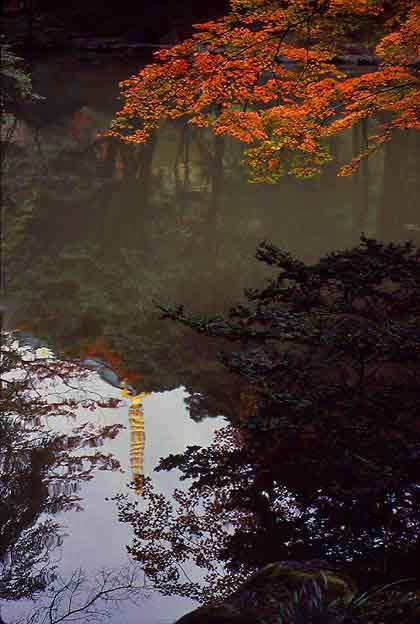
THE IDEA OF PREEXISTENCE
Hearn's musings on the most fundamental philosophical theme of the Buddhist Far East.
"Were I to ask any reflecting Occidental, who had
passed some years in the real living atmosphere of
Buddhism, what fundamental idea especially differentiates
Oriental modes of thinking from our own, I
am sure he would answer: "The Idea of Preexistence."
It is this idea, more than any other, which
permeates the whole mental being of the Far East.
It is universal as the wash of air: it colors every emotion;
it influences, directly or indirectly, almost
every act. Its symbols are perpetually visible, even
in details of artistic decoration; and hourly, by day
or night, some echoes of its language float uninvited
to the ear. The utterances of the people - their
household sayings, their proverbs, their pious or profane
exclamations, their confessions of sorrow, hope,
joy, or despair - are all imbued with it."
Quoted from "The Idea of Pre-Existence" edited by Elizabeth Bisland, 1922
Photo RWFG
TOKYO 1896-1904
Lefcadio Hearn's Last Years.
Tokyo Imperial University 1896-1903

Lafcadio Hearn at Tokyo University 1896-1903
Photo trussel.com
Lafcadio Hearn taught English literature at Tokyo University from 1896 to 1903.
Many literati were among his students: like Ueda Bin, Osanai Kaoru, Doi Bansui.
In 1896 he moved his family from Kobe to Tokyo where
he bought a simple house without garden at 21, Tomihasa-chio, Ichigaya, situated in Ushigome, a suburb of Tokyo until 1902 and taught at the Imperial University of Tokyo. The house no longer exists and only a memorial marker remains.
Waseda University
In 1903 Hearn was appointed to teach English literature at Waseda University.
Though he taught here only half a year, he influenced students like Ogawa Mimei, and made a good friend of Japanese writer Tsubouchi Shôyô, a professorial colleague .
In 1902 Hearn left his house at Ichigaya-Tomihisa-chô and moved to 266, Nishi Okubo close to Waseda.
In 1903 he quit the Imperial University job and taught only at Waseda University
The house no longer exists and only a momorial marker remains. The notation "Here lived Lafcadio Hearn" was written by Edmund Blunden.
Today the monument is located inside the fence of Seijo-Gakuen Women's High School.
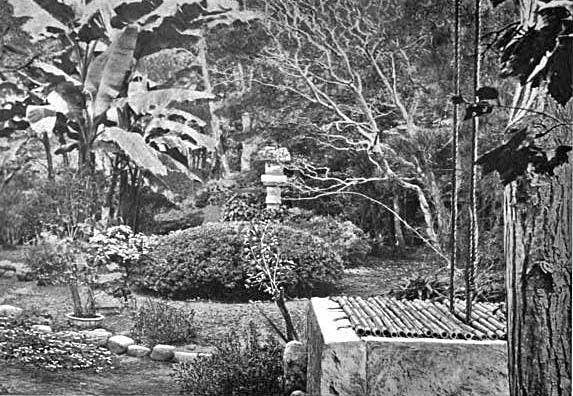
Hearn's garden in Tokyo
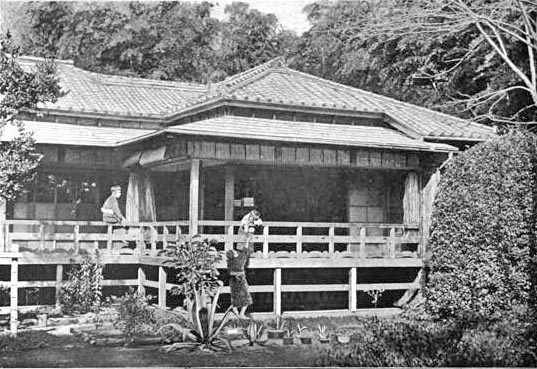
The writing room he added to the house . His children playing on the verandah.
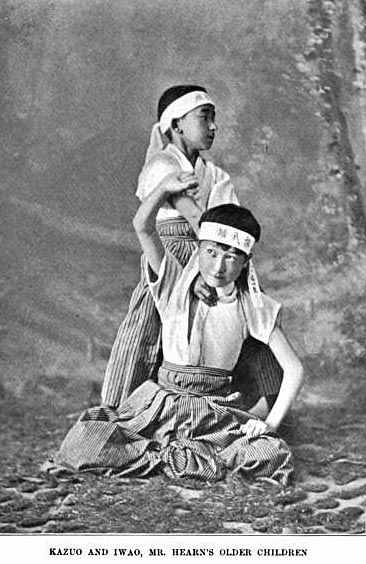
Kazuo and Kiyoshi in Tokyo, 1901
Photos from Elizabeth Bisland, 1906
YAIZU SUMMER 1904
Hearn spent the summer of 1904, his last before he died of a heart attack, at Otokishis's in Yaizu on the coast teaching his two sons swimming. His wife and their little daughter remained in Tokyo.
After obtaining Japanese citizenship, Hearn used his Japanese name Kazuo Koizumi. (His oldest son is also named Kazuo or Kadzuo in Hearn's letters).
Elizabeth Bisland, op.cit., has collected the letters to his wife from this summer.
I copy a few, They are mere notes, but afford a rare glimps into his private, intimate relationship with his wife and family.
LETTERS TO MRS. HEARN
Yaizu, July 12, 1904.
LITTLE MAMMA, — To-day we have not much sunlight,
but I and Kuzuo swam as usual. Kazuo
played a torpedo in the water. He is growing clever in
swimming, to my delight. We had a long walk
yesterday. We bought a little ball and bell for the
cat whose life I had saved and brought home.
The
stone-cutter is showing me his design of the Jizo's
face. Shall I let him carve the name of Kazuo
Koizumi somewhere on the idol? I can see how glad
the Yaidzu people would be to see the new idol.
We have too many fleas here. Please, bring some
flea-powder when you come. But this little delightful
cat makes us forget the fleas. She is really funny.
We call her Hinoko.
Plenty of kisses to Suzuko and Kiyoshi from
Papa.
August 1. 1904.
Little Mama, - Yesterday we had a real big
wave, at the height of the summer season. Otokichi
swam with Kazuo, as he was afraid for Kazuo to go
alone. The sea began to groan terribly since noon;
and at evening the billows grew bigger, and almost
reached the stone wall. It is difficult to swim
this morning also, but I expect that the sea will be
calmer in the afternoon.
The little baby sparrow which I already wrote
you about had been pretty strong for the last three
days; but under the sudden change of weather it was
taken ill.
Last evening Otokichi bought two sharks. Kazuo
studied their shapes carefully; and it was the first
experience for him. Otokichi cooked nicely for our
supper shark's meat, which was white and excellent.
I take some milk in the morning.
August 10. 1904.
Little Mama San, - This morning we had a
pleasant swimming, the sea being warm. Kadzuo
did not swim so well as before, but I think he will
improve in a few days. I noticed his wearing a tiny charm, and asked him what it meant. He answered
that mother, from her anxiety for him, had told him
to wear it whenever he go a-swimming. Iwao swam
a little. He will become a good swimmer.
Ume [Otokichi's son] is now a grown man and
even married. His wife is kind and lovely. This
year Otokichi looks a little older than before. As
to the rampart here, it was the old one that had
got some damage; the new one is very strong. It
is a pity that those ducks and doves are seen no
more.
Loving words from Papa to dear Mamma and
Grandmother.
August 24, 1904.
Little Mama, - Yesterday it was so hot; the
thermometer rose to ninety-one degrees. However,
the winds blew from the sea at night. And this
morning the waves are so high, I only take a walk.
Otoyo gave the boys plenty of pears. Last evening,
Kazuo and Iwao went to a shooting gallery for fun.
We drank soda and ginger ale, and also ate ice.
Iwao has finished his first reader; it seems that
learning is not hard for his little head at all. He
studied a great deal here. And he is learning from
Mr. Niimi how to write Japanese characters.
Just this moment I received your big letter. I
am very glad to hear how you treated the snake you
mentioned. You were right not allowing the girls
to kill it. They only fear, as they don't understand
that it never does any harm. I believe it must be
a friend of Kami-sama in our bamboo bush.
Mr. Papa and others wish to see Mamma's sweet
face. Good words to everybody at home.
Yakumo.
From Elizabeth Bisland, 1910
On September 26, 1904 Hearn died of a heart attack
In a letter written to Mrs. Atkinson - Lafcadio's half-sister by his father's second marriage - some months after
Lafcadio's death, Mrs. Koizumi, his wife, describes his last
hours : "On the evening of September 26th, 1904, after supper,
he conversed with us pleasantly, and as he was about going
to his room, a sudden aching attacked his heart. The pain
lasted only some twenty minutes. After walking to and
fro, he wanted to lie down; with his hands on his breast
he lay very calm in bed, but in a few minutes after, as if
feeling no pain at all, with a little smile about his mouth,
he ceased to be a man of this side of the world. I could
not believe that he would die so sudden. It was his fate."
From Nina Kennard, 1912
LEFCADIO HEARN'S BUDDHIST FUNERAL
A detailed account was given of the funeral by an
American lady, a Miss Margaret Emerson. The funeral procession started from
his residence, 266, Nishi Okubo, at half-past one on September
29th, 1904 and would proceed the 1000 meters to the Jitom Kobduera
Temple in Ichigaya, where the Buddhist service was to be
held. It was one of those luminous Japanese days that had
so often inspired him. Not a cloud veiled the pale azure of the sky. Only the solitary cone of Fuji-yama stood out, a "ghostly apparition"
between land and sea.
He was carried to his last resting-
place preceded by a priest ringing a bell, men carrying
poles, from which hung streamers of paper gohei; others
bearing lanterns and others again wreaths, and huge
bouquets of asters and chrysanthemums, while two boys
in rickshas carried little cages containing birds that were
to be released on the grave, symbols of the soul released
from its earthly prison. Borne, palanquin-wise, upon the
shoulders of six men, of the caste whose office it is to dig
graves and assist at funerals, was the coffin, containing
what had been the earthly envelope of that marvellous combination of good and evil tendencies, the soul of Lafcadio
Hearn.
While the temple bell tolled with muffled beat, the procession
filed into the old Temple of Jitom Kobduera. The
mourners divided into two groups, Hearn's wife, who,
robed in white, had followed with her little daughter in
a ricksha, entering by the left wing of the temple, while
the male chief mourners, consisting of Kazuo, Lafcadio's
eldest son, Tanabe (one of his former students at Matsue),
and several university professors, went to the right.
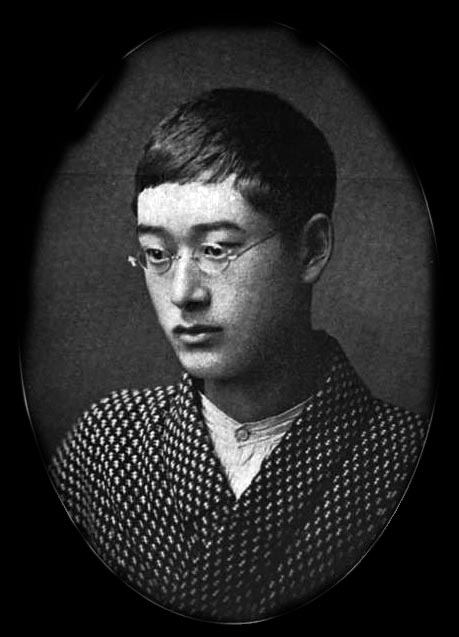
Kazuo, Lafcadio's oldest son at 17.
Then followed all the elaborate ceremonial of the
Buddhist burial service. The eight Buddhist priests
dressed in magnificent vestments chanted the chant of the
Chapter of Kwannon in the Hokkekyo.
After the addresses to the soul of the dead, the chief
mourners rose and led forward Hearn 's eldest son; together
they knelt before the hearse, touching their foreheads
to the ground, and placed some grains of incense
upon the little brazier burning between the candles.
The
wife, when they had retired, stepped forward, leading a
little boy of seven, in a sailor suit with brass buttons and
white braid. She also unwrapped some grains of incense
from some tissue paper, and placed them upon the brazier.
Then, after a considerable amount of bowing and chanting,
the ceremony ended and the congregation left the
temple.
Text and photo from Nina Kennard, 1912
THE END
RETURN TO THE INTRODUCTION










